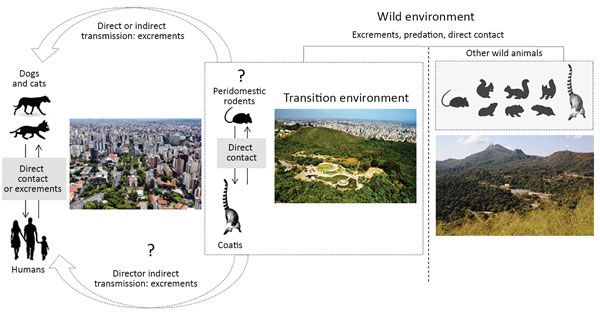Vaccinia Virus among Domestic Dogs and Wild Coatis, Brazil, 2013–2015
Galileu Barbosa Costa, Lara Ribeiro de Almeida, Aline Gabriele Ribeiro Cerqueira, Wander Ulisses Mesquita, Jaqueline Silva de Oliveira, Júlia Bahia Miranda, Ana Teresa Saraiva-Silva, Jônatas Santos Abrahão, Betânia Paiva Drumond, Erna Geessien Kroon, Pedro Lúcio Lithg Pereira, Danielle Ferreira de Magalhães Soares, and Giliane de Souza Trindade
Author affiliations: Universidade Federal de Minas Gerais, Belo Horizonte, Brazil (G.B. Costa, L.R. de Almeida, A.G.R. Cerqueira, J.S. de Oliveira, J.B. Miranda, A.T. Saraiva-Silva, J.S. Abrahão, B.P. Drumond, E.G. Kroon, P.L.L. Pereira, D.F. de Magalhães Soares, G. de Souza Trindade); Universidade Federal de Ouro Preto, Ouro Preto, Brazil (W.U. Mesquita)
Main Article
Figure 2

Figure 2. A hypothetical model developed to visualize the role of domestic animals and wildlife in the natural cycle of vaccinia virus (VACV). The model illustrates the dynamics of VACV circulation in urban and wild areas of Brazil. In urban areas, wild coatis could promote the transmission of VACV between domestic animals or humans because they are in direct contact with domestic dogs and circulate among urban residences. Domestic dogs could also promote the transmission of VACV to humans because of direct contact or possibly indirect contact thought contaminated feces. In the wild environment, coatis can interact with other mammals such as wild rodents, which are believed to be VACV reservoirs, and acquire the infection (this potential interaction is still under investigation).
Main Article
Page created: November 19, 2018
Page updated: November 19, 2018
Page reviewed: November 19, 2018
The conclusions, findings, and opinions expressed by authors contributing to this journal do not necessarily reflect the official position of the U.S. Department of Health and Human Services, the Public Health Service, the Centers for Disease Control and Prevention, or the authors' affiliated institutions. Use of trade names is for identification only and does not imply endorsement by any of the groups named above.
